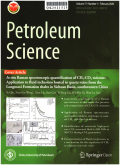- 钛学术文献服务平台 \
- 学术期刊 \
- 工业技术期刊 \
- 石油与天然气工业期刊 \
- 石油科学(英文版)期刊 \
Local events-based fast RTM surface-offset gathers via dip-guided interpolation
Local events-based fast RTM surface-offset gathers via dip-guided interpolation
基本信息来源于合作网站,原文需代理用户跳转至来源网站获取
摘要:
Reverse Time Migration(RTM)Surface Offset Gathers(SOGs)are demonstrated to deliver more superior residual dip information than ray-based approaches.It appears more powerful in complex geological settings,such as salt areas.Still,the computational cost of constructing RTM SOGs is a big challenge in applying it to 3D field data.To tackle this challenge,we propose a novel method using dips of local events as a guide for RTM gather interpolation.The residual-dip information of the SOGs is created by connecting local events from depth-domain to time-domain via ray tracing.The proposed method is validated by a synthetic experiment and a field example.It mitigates the computational cost by an order of magnitude while producing comparable results as fully computed RTM SOGs.

推荐文章
PCI和Local总线冲突问题的研究
PCI总线
Local总线
总线冲突
FIFO
一种低复杂度的LDPC码改进型UMP BP-Based译码算法
低密度校验码
Tanner图
最小均方误差
LLR BP译码算法
UMP BP-Based译码算法
Normalized BP-Based译码算法
Offset BP-Based译码算法
改进型UMP BP-Based译码算法
一种基于区间Bézier曲线的Offset逼近曲线
区间Bézier曲线
Offset曲线
拟合
基于信令寻径式网络的高性能容错VIA设计与实现
VIA
信令寻径式网络
机群计算
并行处理
内容分析
关键词云
关键词热度
相关文献总数
(/次)
(/年)
引文网络
引文网络
二级参考文献 (0)
共引文献 (0)
参考文献 (16)
节点文献
引证文献 (0)
同被引文献 (0)
二级引证文献 (0)
1987(1)
- 参考文献(1)
- 二级参考文献(0)
1991(1)
- 参考文献(1)
- 二级参考文献(0)
1992(1)
- 参考文献(1)
- 二级参考文献(0)
1996(1)
- 参考文献(1)
- 二级参考文献(0)
2002(2)
- 参考文献(2)
- 二级参考文献(0)
2003(1)
- 参考文献(1)
- 二级参考文献(0)
2006(3)
- 参考文献(3)
- 二级参考文献(0)
2010(1)
- 参考文献(1)
- 二级参考文献(0)
2015(1)
- 参考文献(1)
- 二级参考文献(0)
2018(1)
- 参考文献(1)
- 二级参考文献(0)
2019(1)
- 参考文献(1)
- 二级参考文献(0)
2020(1)
- 参考文献(1)
- 二级参考文献(0)
2021(1)
- 参考文献(1)
- 二级参考文献(0)
2021(1)
- 参考文献(1)
- 二级参考文献(0)
- 引证文献(0)
- 二级引证文献(0)
引文网络交叉学科
相关学者/机构
期刊影响力
石油科学(英文版)
主办单位:
中国石油大学(北京)
出版周期:
季刊
ISSN:
1672-5107
CN:
11-4995/TE
开本:
大16开
出版地:
北京市学院路20号石油大院15楼317室
邮发代号:
创刊时间:
2004
语种:
eng
出版文献量(篇)
1221
总下载数(次)
1
总被引数(次)
3649
期刊文献
相关文献
推荐文献
- 期刊分类
- 期刊(年)
- 期刊(期)
- 期刊推荐
一般工业技术
交通运输
军事科技
冶金工业
动力工程
化学工业
原子能技术
大学学报
建筑科学
无线电电子学与电信技术
机械与仪表工业
水利工程
环境科学与安全科学
电工技术
石油与天然气工业
矿业工程
自动化技术与计算机技术
航空航天
轻工业与手工业
金属学与金属工艺
石油科学(英文版)2021
石油科学(英文版)2020
石油科学(英文版)2019
石油科学(英文版)2018
石油科学(英文版)2017
石油科学(英文版)2016
石油科学(英文版)2015
石油科学(英文版)2014
石油科学(英文版)2013
石油科学(英文版)2012
石油科学(英文版)2011
石油科学(英文版)2010
石油科学(英文版)2009
石油科学(英文版)2008
石油科学(英文版)2007
石油科学(英文版)2006
石油科学(英文版)2005
石油科学(英文版)2004

 免费查重
免费查重










